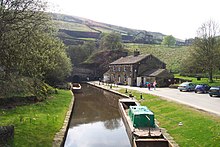Standedge Tunnels

Tunnel End Cottages and the entrance portal at Marsden
|
|
| Overview | |
|---|---|
| Location | Standedge |
| Coordinates | 53°35′28″N 1°57′44″W / 53.59107°N 1.96219°WCoordinates: 53°35′28″N 1°57′44″W / 53.59107°N 1.96219°W |
| OS grid reference | SE026105 |
| Status | Open |
| Waterway | Huddersfield Narrow Canal |
| Start | 53°34′05″N 1°59′34″W / 53.568042°N 1.992684°W |
| End | 53°36′13″N 1°56′33″W / 53.603622°N 1.942506°W |
| Operation | |
| Constructed | 1794–1811 |
| Opened | 1811 |
| Closed | 1944 |
| Rebuilt | 2001 |
| Owner | Canal & River Trust |
| Technical | |
| Design engineer | Nicholas Brown Thomas Telford |
| Length | 5,500 yards (5,029 m) |
| Towpath | No |
| Boat-passable | Yes (with permission) |
The Standedge Tunnels are four parallel tunnels beneath the Pennines in northern England. Three are railway tunnels and the other is a canal tunnel. They are located at the Standedge (pronounced Stannige) crossing point between Marsden and Diggle, across the boundary between the West Yorkshire and Greater Manchester conurbations. Before boundary changes in 1974, both ends of the tunnel were in the West Riding of Yorkshire.
The canal tunnel is on the Huddersfield Narrow Canal. It opened in 1811 and is the longest and oldest of the four and is the longest and highest canal tunnel in the United Kingdom. The first, single-track railway tunnel was completed by the London and North Western Railway (LNWR) in 1848 on the line between Huddersfield and Manchester and a second, parallel, single-track tunnel opened in 1871. The LNWR opened a third, double-track tunnel in 1894. All four tunnels are linked by cross-tunnels or adits at strategic intervals, which allowed the railway tunnels to be built quickly, reducing the need for construction shafts, as waste could be removed by boat.
Of the railway tunnels, only the one built in 1894 is currently used for rail traffic. Closed in 1943, the canal tunnel was re-opened in May 2001. The Standedge Tunnel Visitor Centre, at the Marsden end, is a base for boat trips into the tunnel and hosts an exhibition depicting the different crossings.
The Standedge Tunnel is the longest, deepest and highest canal tunnel in Britain. It is 5,500 yards (5,000 m) long, 636 feet (194 m) underground at its deepest point, and 643 feet (196 m) above sea level.
Benjamin Outram was the consulting engineer for the construction of the Huddersfield Narrow Canal (then known as the Huddersfield Canal) which was authorised by an act of Parliament on 4 April 1794 to link Ashton-under-Lyne and Huddersfield via a tunnel. His report in October 1793 estimated the cost of the canal and tunnel at £178,478. Nicholas Brown surveyed the route. Outram thought that the hill through which the tunnel was to be cut was composed of gritstone and strong shale and should not present any difficulties. He expected to start work on the 5,456-yard (4,989 m) tunnel at a dip in the hill at Red Brook and from both ends and use steam engines to keep the works drained.
...
Wikipedia
